THE LV
In a Nutshell
Backroom Boy
All Male
All Muscle
Loves Football
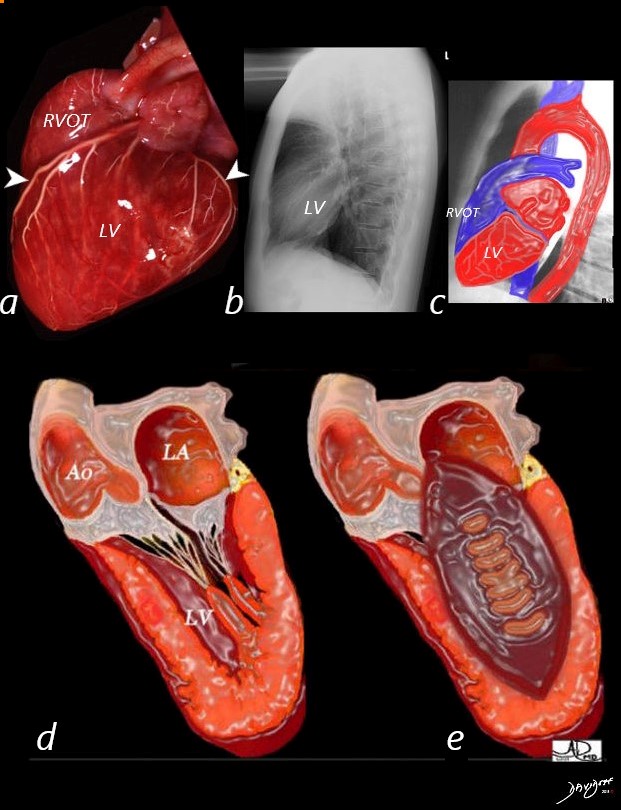
A lateral projection of an anatomic specimen of a normal heart with coronary barium angiogram (a) shows the posterior positioning of the LV in relation to the right ventricular outflow tract (RVOT) (“backroom boy”)
The front arrowhead points to the LAD and the back arrowhead points to the 3 rd obtuse marginal artery.
The lateral CXR of a normal heart (b) and correlative diagram (c) exemplifies the posterior positioning of the LV in relation to the RVOT.
The artistic rendition of the LV (d) demonstrates the “all muscle” concept, while the football ovoid shape of the LV pointing down and leftward (d) demonstrates the “loves football” concept
Ashley DAvidoff MD
32079 buzz LV.8
PA CXR – Normal Size on the Frontal View
In a Nutshell
-
- C-T Ratio
- .5
- LV Hides behind the missus
- Missus is a Triangle
- C-T Ratio
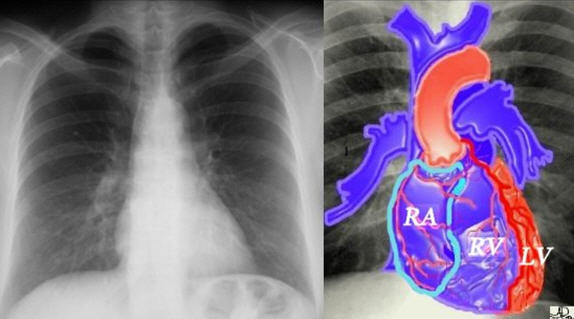
Ashley Davidoff MD
PA CXR
Enlarged LV
In a Nutshell
Size >.5
Down and Out
Football in the LV
Cardiothoracic Ratio
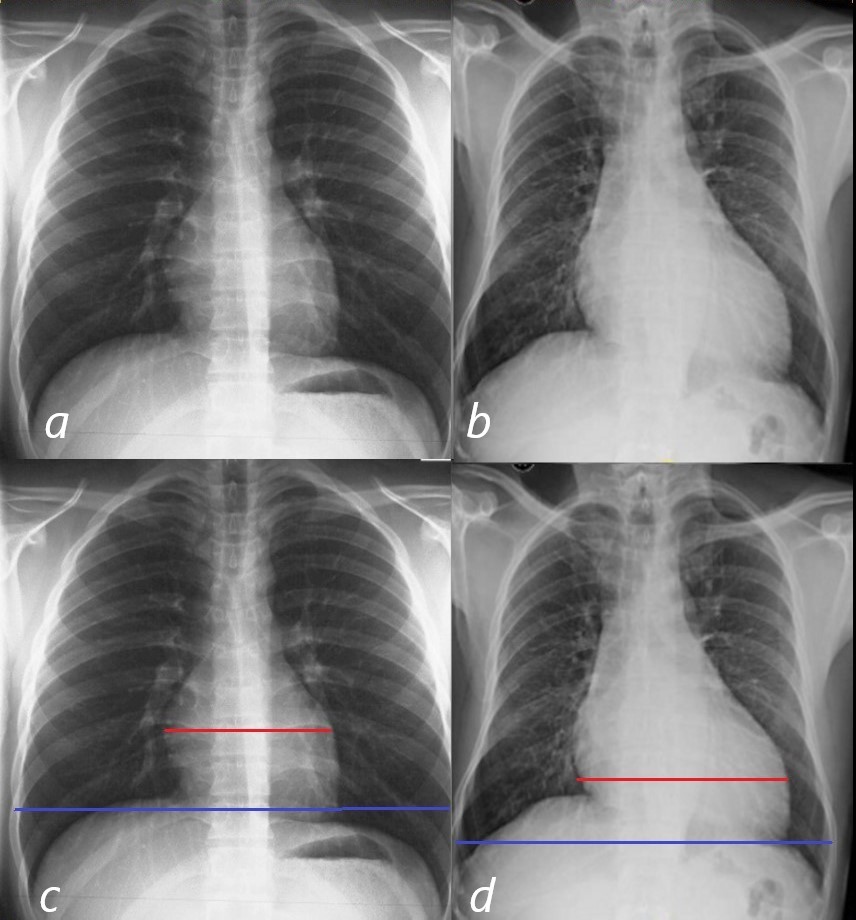
In this instance images a and c show a ratio that is less than .5 and heart size is considered normal. Images b and d are abnormal since the ratio is greater than .5 and by virtue of the shape of the heart LV enlargement is suggested
Ashley Davidoff MD
Shape Suggesting LV Enlargement
Buzz
Down and Out
Football
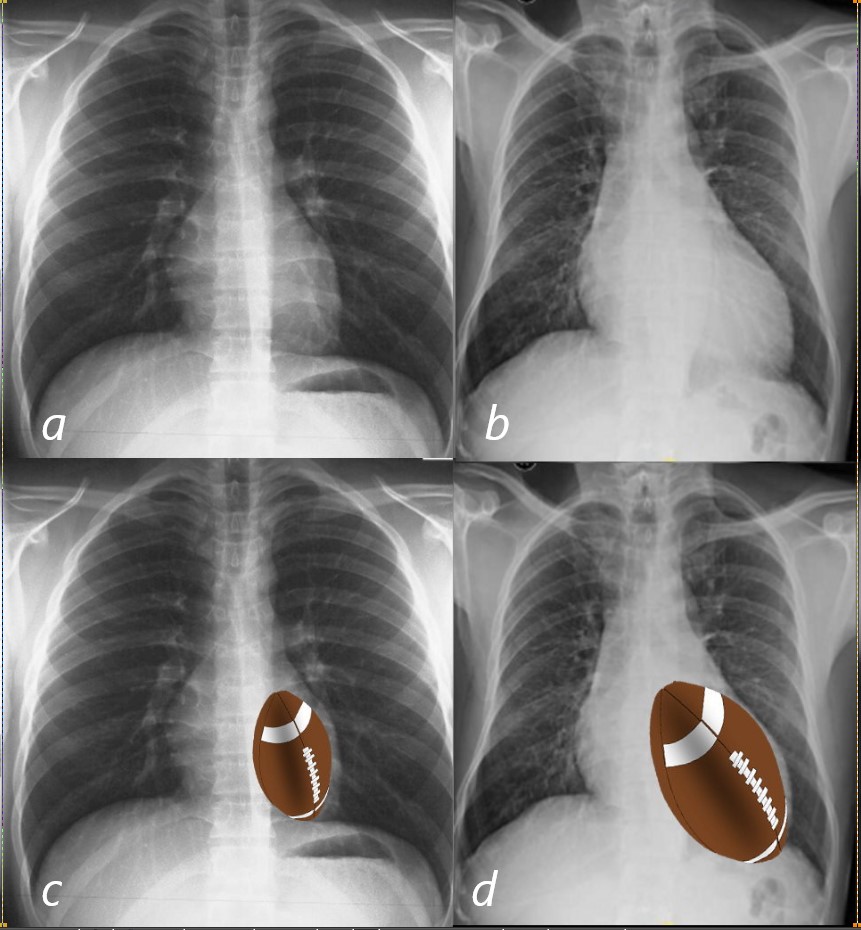
The LV is oval in shape and when it enlarges it advances down and leftward and posteriorly. The oval shape is reminiscent of a rugby ball or a football.
In this instance images a and show a normal shape and size of the left side of the heart . Images b and d are abnormal The heart is enlarged and shows downward and leftward vector
Ashley Davidoff MD
30397 b03L

The enlarged LV (a,b) is shaped like an oval and it is likened to a rugby ball or an American football placed on the field at kick off time. LVE on CXR is mostly assessed by an increased cardiothoracic ratio as well as the accentuation of the ovoid shape. (lower images c, d,e, f)
Ashley Davidoff MD

The left ventricle (LV) enlarges in a downward and lateral direction resulting in the apical impulse displacement and increase forcefulness of the apical tap.
Ashley Davidoff MD
The Lateral – Normal
In a Nutshell
It happens in the backside – LV is the buttocks of the heart
LV is bottom and back
Rule of thirds
Anatomy of the Normal Lateral Examination
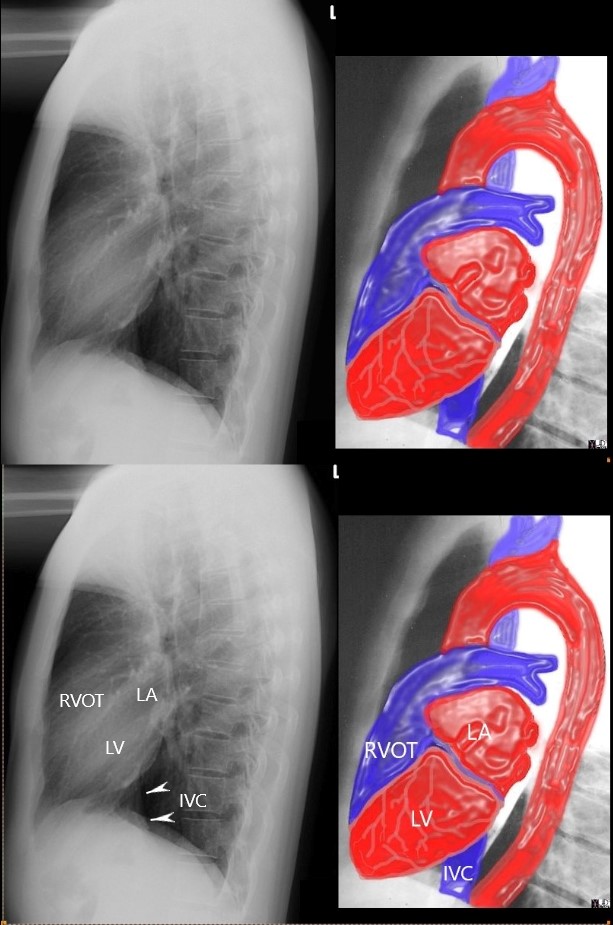
Ashley Davidoff MD
Rule of Thirds
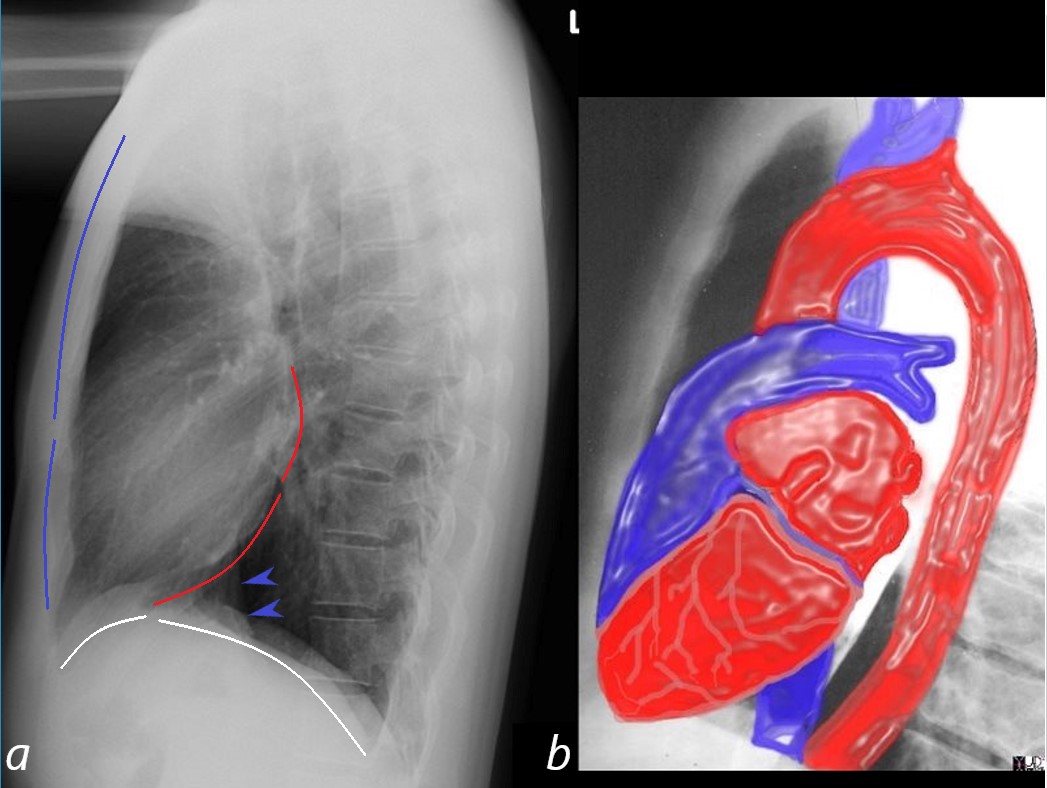
A normal lateral examination of the chest X-ray (CXR, a) shows the relative size and ratios of the anterior border of the heart in relation to the sternomanubrial junction (blue lines), the inferior border of the heart in relation to the diaphragm (white lines) and the posterior border of the heart (red lines)
The first rule of thirds states that the ratio or relative length of the anterior border of the heart (bottom blue line) is about 1/3 t of the length from the inferior border of the heart to the sternomanubrial junction (top blue line) . When the right ventricle is enlarged, the heart takes up more than a 1/3 of this space, and fills in the retrosternal air space indicating right ventricular enlargement RVE).
The second rule of thirds (white lines) states that the ratio or relative length of the inferior border of the heart (front white arc) is about 1/3 the length from the posterior inferior border of the heart to the insertion point of the left hemidiaphragm posteriorly (posterior white arc). When this ratio increases then there is left ventricular enlargement (LVE).
The third rule of thirds (red arcs) states that the ratio or relative length of the posterior border of the left atrium (LA top red arc)) is about 1/3 of the length from the inferior border of the LA to the inferior border of the LV on the left hemidiaphragm (bottom red arc). When this ratio increases then there is left ventricular enlargement (LVE).
A fourth rule (not shown) relates to the relative position of the IVC (blue arrow heads) states that if one draws a 2.5cms vertical line from point where the IVC emerges from the abdomen, and then measures 2.5cms posteriorly, then the posterior border of the LV should be within that 2.5 cms. horizontal line. If the border of the LV is beyond that horizontal line, then LVE is present.
Ashley Davidoff MD
15416C02W lateral.thirds
Left Ventricular Enlargement
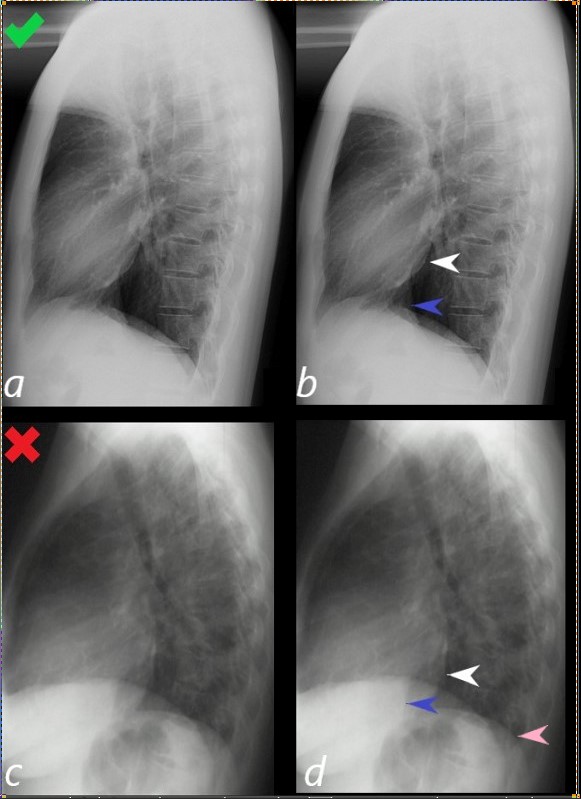
Lateral examination of a chest x-ray (CXR) shows the normal in the upper row (a,b) and the abnormal and enlarged in the bottom row (c,d).
The objective evaluation is based on the relative positioning and size of the LV (white arrowhead) in relation to the IVC, (blue arrowhead), and the left hemidiaphragm (pink arrowhead)
Ashley Davidoff MD
15416C02Wlateral LV01L.8

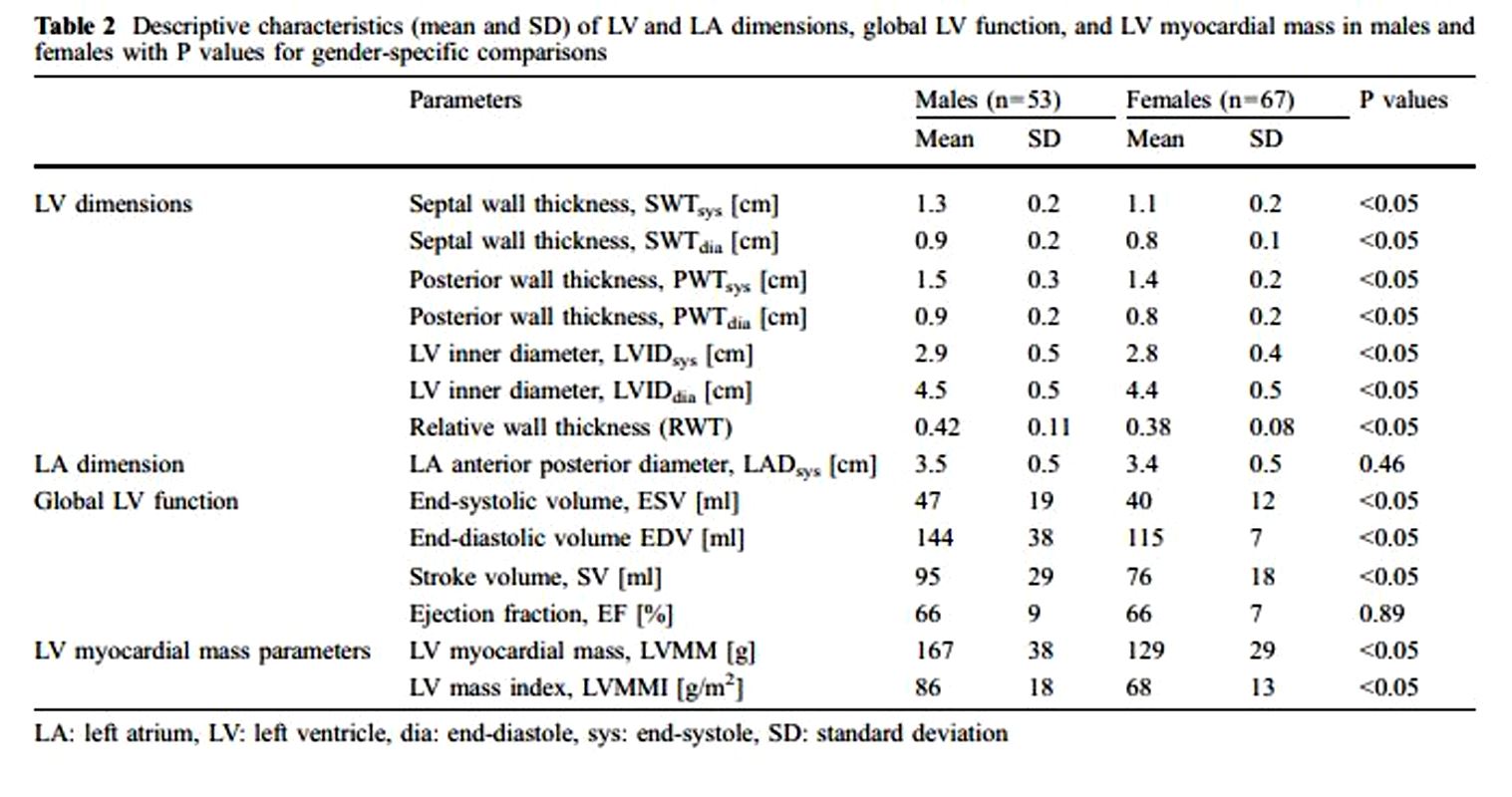
Reference values for quantitative left
ventricular and left atrial measurements
in cardiac computed tomography
Eur Radiol (2008) 18: 1625?1634
Left Ventricular Enlargement – Objectivity
Wall Thickness
Buzz
Thickness in Diastole
1.1
Diameter in Diastole
4.5cms CT
End Diastolic Volume
150cc males/120ccs females
Normal thickness of the left ventricular myocardium is from 0.6 to 1.1 cm (as measured at the very end of diastole. If the myocardium is more than 1.1 cm thick, the diagnosis of LVH can be made.
The left ventricular free wall is thickest at the base and it
gradually thins towards the apex. At the tip of the apex
myocardium is 1?2 mm thick,
The interventricular septum increased from a median of 8.3 mm in the age group 20-29 to 11.2 mm in the group 60-70, whereas the posterior left ventricular wall increased from 7.5 mm to 9.8 mm.
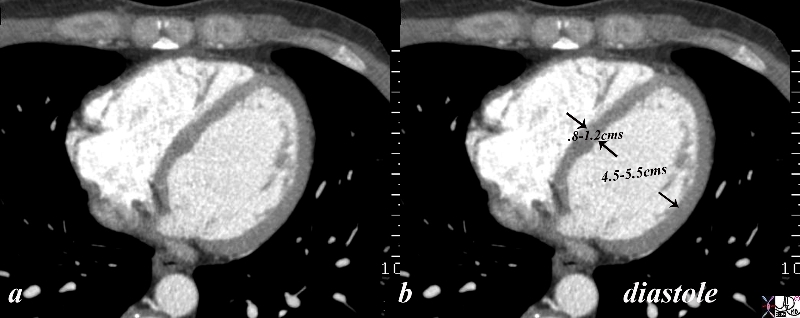
The gated CT scan was taken in diastole and shows the normal left ventricular dimensions which for the left ventricle wall is between .8 cms and 1.2 cms, and for the cavity is 4.5-5.5cms. the measurement should be taken at the level of the papillary muscles which is in mid ventricular cavity.
code
Courtesy Ashley Davidoff copyright 2018
34765c02.8s
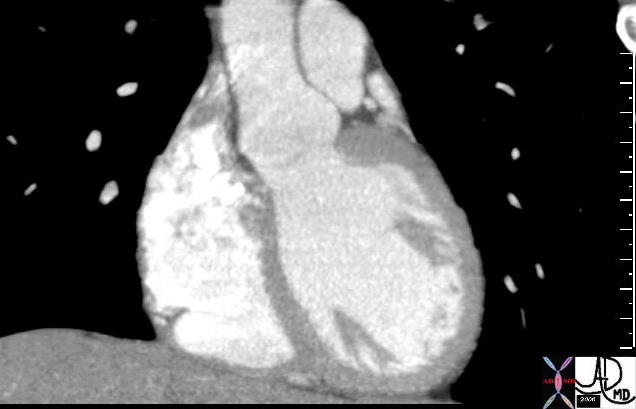
key words right atrium heart cardiac RA tricuspid valve TV left atrium LA MV mitral valve RV right ventricle anterolateral papillary muscle interventricular septum left ventricle LV CTscan
Ashley Davidoff MD
34780

Ashley Davidoff MD
130617
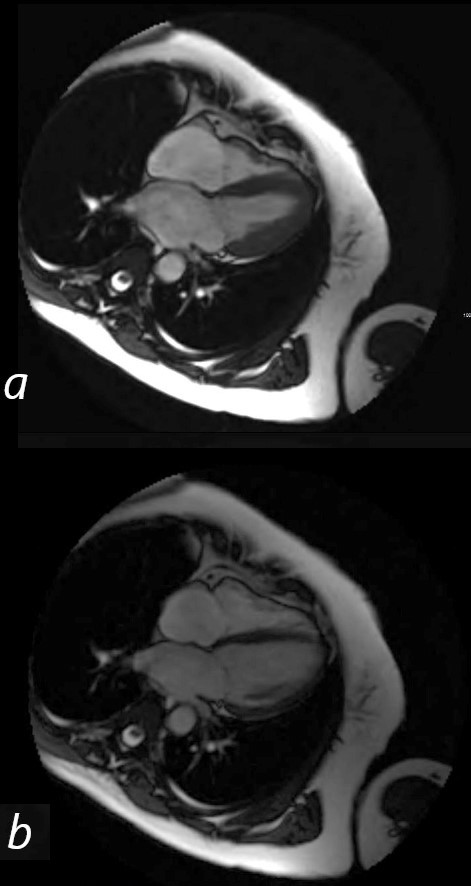
Ashley Davidoff MD
130615cL01
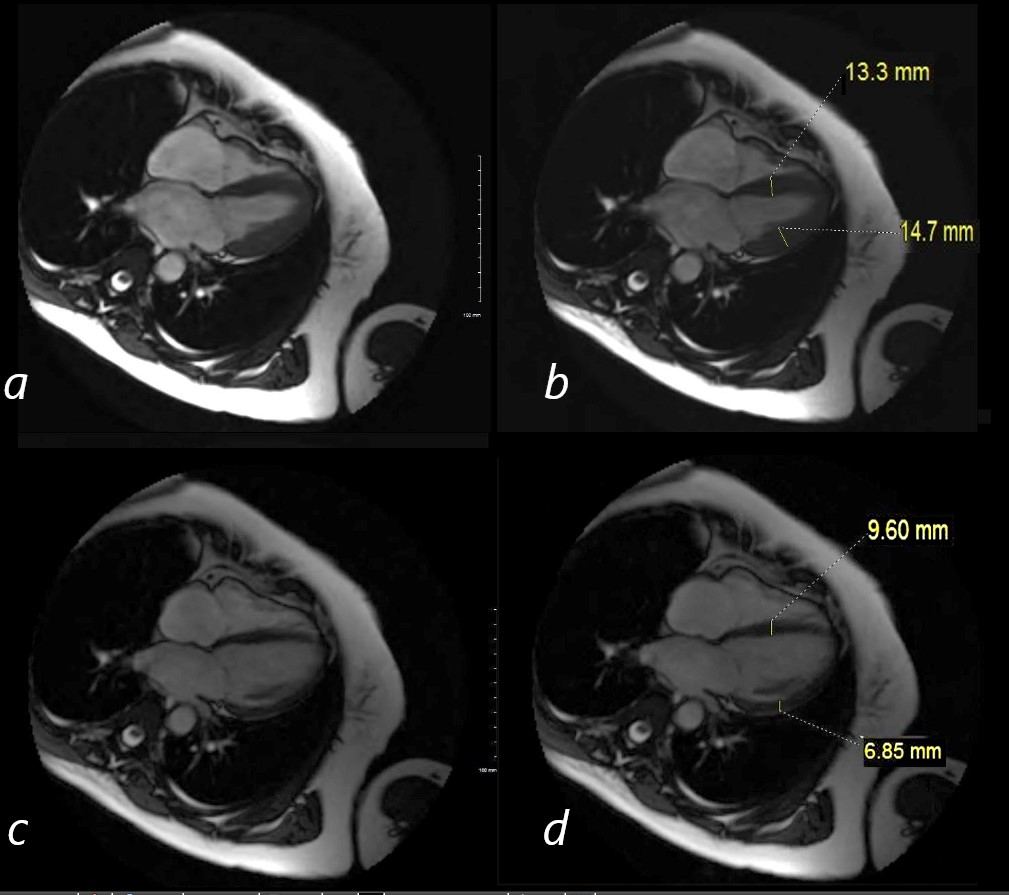
Ashley Davidoff MD
130615cL

Dilated LV
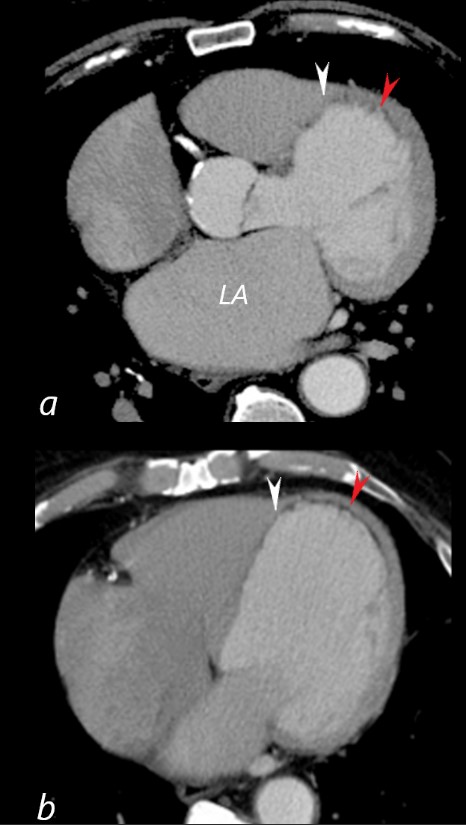
41 year old male presents with chest pain.
Axial CT with contrast at the level of the enlarged left atrium (LA) (a) reveals a dilated LV, with subendocardial fatty infiltration of the LV myocardium in the septum (white arrowhead), and apex red arrowhead). There is thinning of the myocardium in the septum and apex.
Image B is more inferior and taken at the level of the dilated RA and normal sized RV showing similar subendocardial fatty infiltration of the LV myocardium in the septum (white arrowhead), and apex red arrowhead). There is thinning of the myocardium in the septum and apex. The transverse dimension of the LV was 7.2 cms which is significantly dilated
These findings are consistent with myocardial infarction with and ischemic cardiomyopathy.
Ashley Davidoff MD
86943c03L

In the gated MRI, systole and diastole can be differentiated and so standard measurement to thickness and volume can be applied, for evaluation of size. This MRI series demonstrates the heart in systole and diastole. Image 1 demonstrates ventricular systole. The atrial chambers are full, the A-V valves (tricuspid valve and mitral valve) are closed and the ventricular chambers are contracted. Image 3 is a color overlay of the closed A-V valves of image 1. Image 2 demonstrates ventricular diastole. The atrial chambers are emptying, the A-V valves are open and the ventricular chambers are full. Image 4 is a color overlay of the open A-V valves of image 2. 32062
Left Ventricular Mass
Estimated LV mass of 201 to 227 g (103 to 116 g/m2) for men and 151 to 171 g (89 to 100 g/m2) for women is mildly abnormal.
?Estimated LV mass of 228 to 254 g (117 to 130 g/m2) for men and 172 to 193 g (101 to 112 g/m2) for women is moderately abnormal.
?Estimated LV mass >254 g (>130 g/m2) for men and >193 g (>112 g/m2) for women is severely abnormal.
Causes of LVH
Systemic hypertension
?Aortic stenosis (valvular, supravalvular, or subvalvular)
?Aortic regurgitation
?Mitral regurgitation
?Dilated cardiomyopathy
?Hypertrophic cardiomyopathy
?Ventricular septal defect
?Some infiltrative cardiac processes (eg, Fabry disease, Danon disease)
LVH without EKG findings
?Amyloidosis
?Sarcoidosis
?Hemochromatosis
EPIDEMIOLOGY
Left Ventricular Hypertrophy – LVH

Ashley Davidoff MD
Size of the Left Ventricular Cavity
Buzz
3.5cms CT (same as ascending aorta)4.4 Echo
The mean (SEM) LV internal diameter at nongated multidetector computed tomography between the group with normal LV and the group with LVE by echocardiography was 4.4 (0.7) cm for the normal LV and 5.9 (1.2) cm for the dilated LVs (P < 0.0001).

The gated CT scan was taken in diastole and shows the normal left ventricular dimensions which for the left ventricle wall is between .8 cms and 1.2 cms, and for the cavity is 4.5-5.5cms. the measurement should be taken at the level of the papillary muscles which is in mid ventricular cavity.
code
Courtesy Ashley Davidoff copyright 2018
34765c02.8s
Mild Dilatation
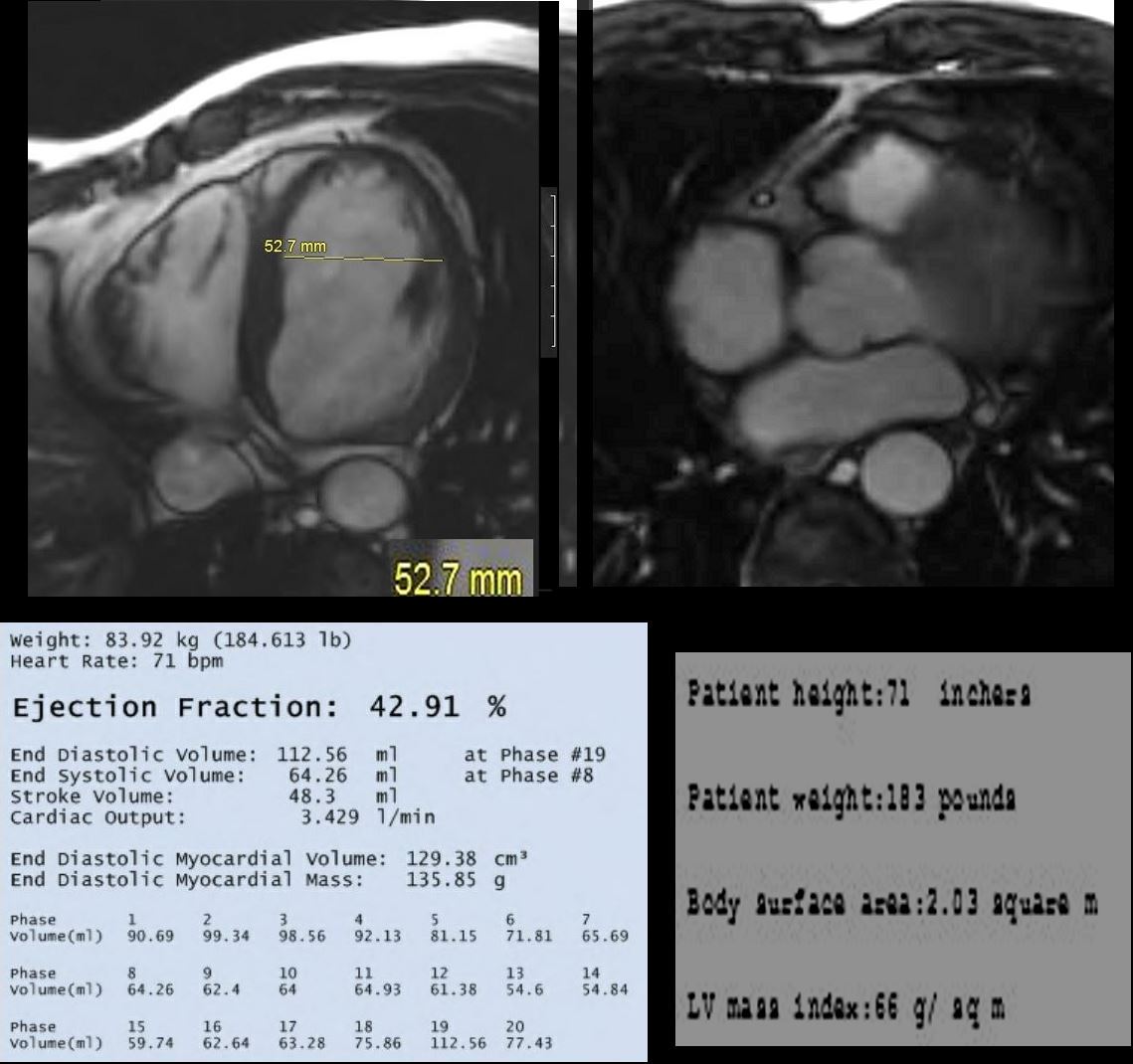
Axial MRI through mid ventricle using white blood imaging algorithm, in a 66 year old male with mild dyspnea, shows mild left ventricular (LV) enlargement (LVE) with an internal diameter of 5.3cms (normal 4.5cms) (top left), normal sized left atrium (LA) approximating the size of the normal aorta (Ao) with an ejection fraction of 43% and normal end diastolic volume (112 ccs) and normal LV mass (66gms/sq m)
Ashley Davidoff MD
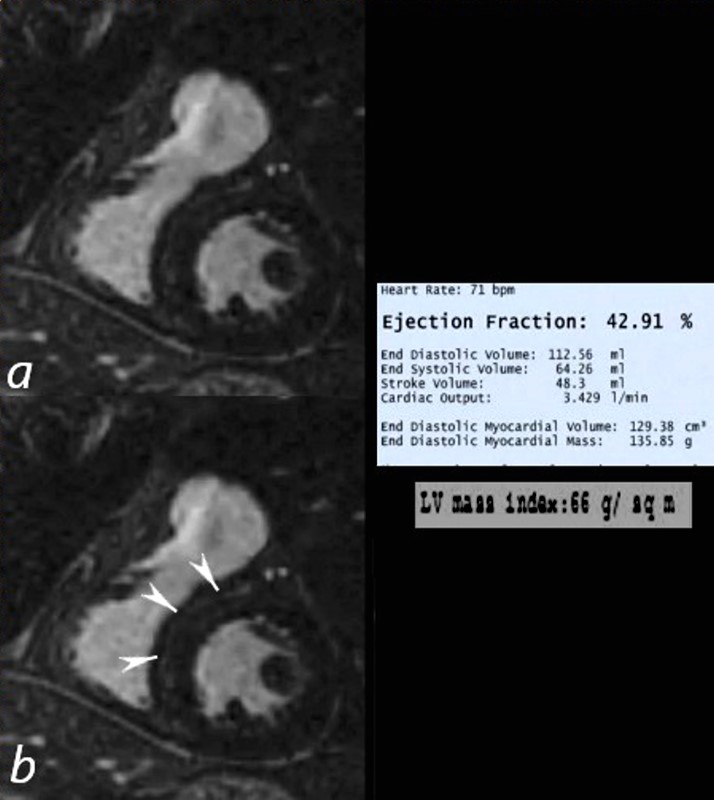
Short axis MRI in a 66 year old male with mild dyspnea, post gadolinium infusion through mid ventricle using white blood imaging algorithm, shows linear enhancement in the mid myocardium of the septum (white arrows in b) consistent with congestive cardiomyopathy. Myocarditis is included in the radiological differential diagnosis.
Ashley Davidoff MD
End Diastolic Volume of the Left Ventricle
References and Links
Kathiria NN et alAssessment of Left Ventricular Enlargement at Multidetector Computed Tomography. J Comput Assist Tomogr. 2015 Sep-Oct;39(5):794-6.
The American society of echocardiography recommendations for
cardiac chamber quantification in adults: a quick reference guide from the ASE workflow and lab management task force
-
TCV
Cavity
